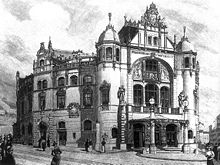Vienna Volksoper

The Vienna Volksoper (Volksoper Wien or Vienna People's Opera) is a major opera house in Vienna, Austria. It puts on around three hundred performances of twenty-five German language productions during an annual season which runs from September through June.
History
Foundation

It was built in 1898 as the Kaiser-Jubiläums-Stadttheater (Kaiser's Jubilee Civic Theatre), originally producing only plays. Because of the very brief construction period (10 months) the first director Adam Müller-Gutenbrunn had to start with debts of 160,000 gulden. After this inauspicious startup the Kaiser-Jubiläums-Stadttheater had to declare bankruptcy five years later in 1903.
Music Theater from 1903 to 1950s
On 1 September 1903 Rainer Simons took over the house and renamed it the Kaiser-Jubiläums-Stadttheater - Volksoper (public opera). His intention was to continue the production of plays but also establish series of opera and operetta. The first Viennese performances of Tosca and Salome were given at the Volksoper in 1907 and 1910 respectively. World famous singers such as Maria Jeritza, Leo Slezak and Richard Tauber appeared there; the conductor Alexander Zemlinsky became the first bandmaster in 1906.
In the years up to and through the First World War the Volksoper attained a position as Vienna's second prestige opera house. In 1919, Felix Weingartner became Artistic Director and Principal Conductor. He was followed as Director by Hugo Gruder-Guntram. After 1929, it focused on light opera, and under Gruder-Guntram undertook a number of summer tours to Abbazia in 1935, Cairo and Alexandria in 1937 and throughout Italy in 1938, with guest appearances from Richard Tauber. After the Second World War, the Vienna Volksoper became the alternative venue to the devastated Vienna State Opera. In 1955 the Volksoper returned to its former role of presenting opera, operetta, and musicals.
Recent history
From September 1991 to June 1996 the Vienna Volksoper was under a collective leadership with the Vienna State Opera. In 1999 the Volksoper became a 100% subsidiary of the Bundestheater-Holding. Since 1 September 2007 Robert Meyer has headed the Volksoper as artistic director together with the business manager Christoph Ladstätter. Each season includes about 25 productions, a total of approximately 300 performances—a performance almost every day. In addition to opera, operetta, musicals and ballet, there are special performances and children's programs.
Facts and figures
Seating

On three different levels there are 1261 seats and 72 standing room places as well as two places for wheelchairs.
Number of performances by year
| Season | Performances | spectators | avg. utilisation | avg. employees |
|---|---|---|---|---|
| 2004/2005 | 287 | 293,695 | 75,41% | unknown |
| 2005/2006 | 276 | 280,520 | 74,77% | 524 |
| 2006/2007 | 281 | 289,721 | 78,34% | 523 |
| 2007/2008 | 291 | 325,491 | 85,77% | 526 |
Technical Data
The orchestra pit is equipped with two electrically driven stage lifts, with a loading capacity of 500 kg/m². It is adjustable in height from 0 to 2.65 meters below stage level.
The red velvet house curtain is hydraulically drawn and liftable. The gather velocity is 0.15 to 3.0 m/s, the lift velocity can be up to 2.0 m/s.
The stage is 17.2 meters wide and 19 meters deep and has a mechanic load capacity of 500 kg/m². In the middle of the stage is a turnable and liftable circular platform, around which is a turnable ring platform with an external diameter of 15 meters. There are also 3 hand-operated person trap mechanisms.
Organisational structure
Since 1999 the Volksoper Vienna is a 100% subsidiary of the Bundestheater Holding AG (Federal theater holding AG) along with the Vienna State Opera and the Burgtheater (en: (Imperial) Court Theatre). The Bundestheater Holding AG is owned by the Republic of Austria. The Holding also holds 51.1% of the Theaterservice Gmbh, which offers services in design and administrational matters. The remaining 48.9% are shared equally among the three theater houses (16.3% each).
In popular culture
This section needs expansion. You can help by adding to it. (February 2010) |
In 1987, the opera house was used for a scene set in Bratislava, Czechoslovakia (now part of Slovakia), for the James Bond film The Living Daylights, where Timothy Dalton made his debut as Bond near the very beginning of the film, where he first spotted the key female character Kara Milovy (played by Maryam d'Abo). [1]
See also
External links
- Official website, in English
- Profile from Wien.info
- website Bundestheater Holding Website der Bundestheater Holding, in English
